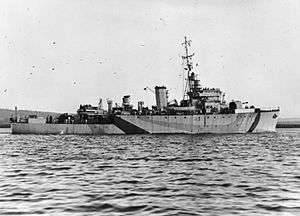HMS Rifleman (J299)
HMS Rifleman was an Algerine-class minesweeper of the Royal Navy. She was launched in 1943 and saw active service during World War II, both in the European and Far East theatres. After the war she served in the Mediterranean and was used as an accommodation ship in Barrow before being sold for breaking in 1972.
 Rifleman during World War II | |
| History | |
|---|---|
| Name: | HMS Rifleman |
| Builder: | Harland and Wolff, Belfast |
| Yard number: | 1205[1] |
| Launched: | 25 November 1943 |
| Completed: | 11 February 1944[1] |
| Commissioned: | 11 February 1944 |
| Identification: | Pennant number: J299 |
| Honours and awards: | Normandy 1944, Burma 1945 |
| Fate: | Sold for breaking in 1972 |
| Badge: | On a Field Green, a Maltese cross surmounted by a Roundel Gold, charged with a bugle, stringed, Black. |
| General characteristics | |
| Class and type: | Algerine-class minesweeper |
| Displacement: | 850 tons |
| Length: | 225 ft (69 m) |
| Beam: | 35 ft 6 in (10.82 m) |
| Installed power: | 2,000 ihp (1,500 kW) |
| Propulsion: |
|
| Complement: | 85 |
| Armament: |
|
Construction
The ship was launched from the Harland and Wolff yard in Belfast on 25 November 1943 and commissioned on 11 February 1944.
History
World War II
From June to August 1944 Rifleman was engaged in minesweeping and escort duties for Operation Neptune, the Allied invasion of Normandy. In September she was nominated for Air Sea Rescue duties during the Arnhem airborne assault, and in October she carried out mine clearance operations in the Scheldt estuary and escorted a military convoy to Antwerp.[2]
She was transferred to the South West Approaches with the rest of her Flotilla and was employed in anti-submarine patrols out of Falmouth until December, when she was refitted for service in the Far East.[2]
In February 1945 Rifleman rejoined her Flotilla and together they formed the escort for a convoy of Landing Ships (Tank) from Falmouth to Gibraltar. On 22 February she rescued some of the 41 survivors from the German submarine U-300 which had been attacked by sister ship Pincher. Rifleman arrived at Colombo on 14 April and on 1 May she began minesweeping the approaches to Rangoon for the assault ships. In June she was at Trincomalee to prepare for planned minesweeping off Phuket Island and during July she and her sisters came under sustained air attack, with Squirrel and Vestal being sunk. This operation was named Livery.[2]
At the end of August Rifleman carried out minesweeping operations to clear the approaches to Penang for the entry of the battleship Nelson, and the cruisers Cleopatra and Sussex. In September, the minesweeper performed the same task in the Malacca Straits prior to the entry into Singapore.[2]
Post-war
The minesweeper remained in the Far East with her Flotilla to remove mines for the safety of navigation, returning of the UK in July 1946. She was paid off at Sheerness in September 1946, reduced to Reserve and laid up.[2]
Rifleman was recommissioned into the 2nd Minesweeping Flotilla of the Mediterranean Fleet after refit in 1947. In 1953 the vessel took part in the Fleet Review to celebrate the Coronation of Queen Elizabeth II.[3] At the end of 1954 she returned to the UK and was again reduced to Reserve and laid up. During 1958 and 1959 she was refitted. In 1970 the ship was sent to Barrow and used to provide accommodation, including for personnel standing by submarines under construction by Vickers-Armstrong.[2]
Fate
She was placed on the Disposal List in 1972 and sold to BISCO for breaking by W H Arnott Young at Dalmuir.[2]
References
- McCluskie, Tom (2013). The Rise and Fall of Harland and Wolff. Stroud: The History Press. p. 153. ISBN 9780752488615.
- "HMS Rifleman at NavalHistory.net". Retrieved 30 June 2009.
- Souvenir Programme, Coronation Review of the Fleet, Spithead, 15th June 1953, HMSO, Gale and Polden
Publications
Colledge, J. J.; Warlow, Ben (2006) [1969]. Ships of the Royal Navy: The Complete Record of all Fighting Ships of the Royal Navy (Rev. ed.). London: Chatham Publishing. ISBN 978-1-86176-281-8.